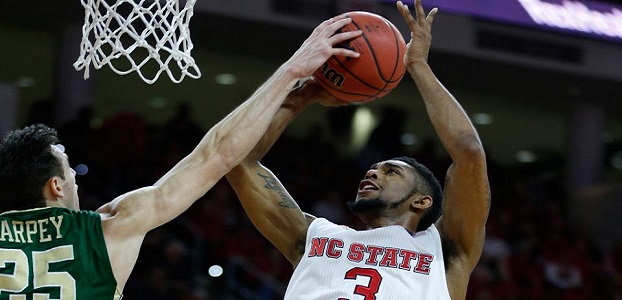Terry Henderson spent the entire 2014-15 season sitting on the bench for NC State, following his transfer from West Virginia. This made it especially cruel when Henderson injured his ankle seven minutes into his first game in a Wolfpack uniform and had to miss the remainder of the season.
After scoring 566 points in two seasons in Morgantown, the Raleigh native has yet to score a single point for NC State. It’s been 960 days since Henderson last scored in a college game — when he dropped 13 in WVU’s NIT loss to Georgetown.
This is a transition season for the Wolfpack; there are a lot of new faces on the roster, and while Henderson is in his third year with Mark Gottfried’s club, he’s still an unknown.
What NC State needs Henderson to be is a shooter who can space the floor and create on opposing defenses once Dennis Smith Jr. has bent them in another direction.
It looks like he has the chops to do just that.
During his two seasons at West Virginia (2012-14), Henderson chucked 230 three-point attempts and connected on 38.7 percent. He shot 84.8 percent from the free-throw line as a sophomore (2013-14), which would’ve been a top-five number in the Big 12 if he’d qualified for the minimum number of attempts.
He also finished that year 16th in the Big 12 in true shooting percentage (57.1 percent). He was a good fit for the open post offense of Bob Huggins — a motion scheme that puts an emphasis on cutting and screening. Guards have to be able to do a lot; they’re the nucleus of the offense. The fact that Henderson had success in this type of attack bodes well for his ability to assimilate into Gottfried’s high-post motion offense.
With Gottfried steering the ship, NC State’s attack has done a great job featuring shooters, including another transfer — Ralston Turner, who previously spent two seasons ripping nets for LSU. Scott Wood and Turner never shared the floor together while at NCSU, but over the course of four separate seasons, they were prolific shooting from distance. Wood and Turner each played two seasons for Gottfried, and during that time (2011-15), they combined to launch 931 threes (6.5 per game). They connected on 39.7 percent of those bombs.
If Henderson can fill a similar role, it would give the Wolfpack the perfect spacing agent it needs to stretch defenses around spread pick-and-rolls between Smith and Abdul-Malik Abu or Omer Yurtseven.
Last season, Cat Barber had to drive into a collection of trees every time he entered the lane; Smith shouldn’t have to deal with that. Henderson is more than just a standstill shooter; he won’t just camp in the corner. State’s offense highlights shooters who move without the ball — running them off pin-downs, double screens and the occasional elevator door play (a personal favorite of mine). When opponents close out hard, Henderson has the game to put it on the floor and finish with a fury at the rim.
Henderson posted offensive ratings above 116 points per 100 possessions in both of his seasons at West Virginia. He’s a highly efficient player, not just because of his jumper and free-throw accuracy, but also because of his low turnover rate. As a sophomore, Henderson had an average usage rate (19.7 percent, according to Ken Pomeroy), and he turned the ball over just 30 times in 756 minutes of action. His turnover rate of 11.8 percent ranked 175th in the nation, per KenPom.
NC State is once again projected to have a top-30 offense nationally — 108.9 points per 100 possessions. Smith will be the team’s engine, but Henderson must provide perimeter support on the offensive end of the floor for this team to reach its ceiling.

















